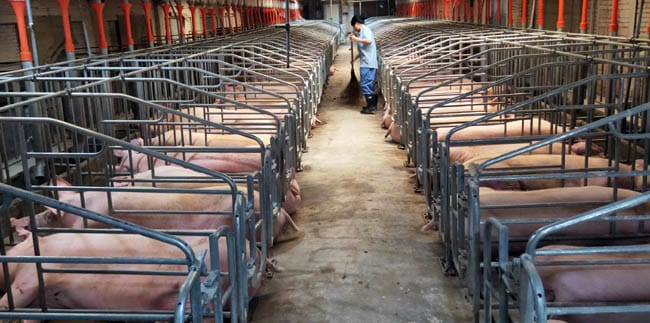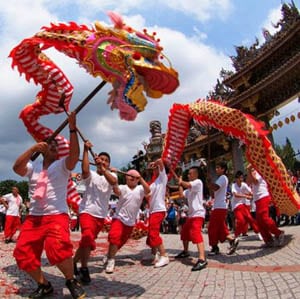
A confined pig breeding facility operated by Jiangxi Zhengbang Breeding Company in Jiangxi Province.
Part 6 of an article on the causes and implications of global capitalism’s descent into an era when infectious diseases are ever more common. My views are subject to continuing debate and testing in practice. I look forward to your comments, criticisms, and corrections.
- Part 1: An Existential Threat
- Part 2: Relentless Viral Evolution
- Part 3: Systematically Unprepared
- Part 4: Deforestation and Spillover
- Part 5: The Pandemic Machines
- Part 6: China’s Livestock Revolution
- Part 7: Wildlife Farms and Wet Markets
- Part 8: Deadly Heat
by Ian Angus
Fifteen months before COVID-19, a pandemic broke out in China.
African Swine Fever (ASF)[1] has been endemic in wild boars and hogs in sub-Saharan Africa for centuries. In the early 1900s it jumped from wild boars to domesticated pigs imported to Kenya from Europe by colonists. Since then there have been outbreaks in various parts of the world, caused in some cases by feral pigs and wild boars, in others by humans transporting infected pigs or contaminated feed. There is no treatment or vaccine, and close to 100 percent of infected animals die..
When ASF was diagnosed in pig farms in northeastern China in August 2018, the Chinese government immediately ordered the slaughter of all pigs in the area — 38,000 in all. Unfortunately, as subsequent genetic analysis proved, the disease had already been circulating undetected for several months, so the cull was too late. The virus was already on the move. In short order there were outbreaks in every province, and plague had spread to 14 other countries in the Asia-Pacific region. Officially, between 2018 and 2019 the number of farmed pigs in China fell 28 percent, from 428 million to 310 million. Pork production plunged and the retail price of pork — the most popular meat in China — more than doubled.[2]
The rapid spread of African Swine Fever was a direct result of radical changes in China’s livestock industries. The near-universal adoption of mass production in confined facilities made something like the ASF pandemic all but inevitable. The same changes contributed to the rapid spread of COVID-19.
+ + + +
There is an ongoing debate on the left about whether Chinese society as a whole is socialist, capitalist, or something new and unique. I won’t attempt to resolve or even address that question here, but I think there can be no doubt that in recent decades China’s agricultural sector has become distinctly capitalist. That’s particularly true of livestock, where the production model developed by Tyson Foods and other US agrifood corporations has been almost universally adopted.
The transformation began in 1978, when the Mao-era agricultural communes were dismantled, replaced first by individual family holdings, and then by a largely unregulated market system in which millions of small farms were squeezed out by agribusiness corporations. In livestock this change first affected poultry.
“Up until the mid-1980s, poultry production was a minor sideline activity for rural households to supplement other farming activities. Millions of small farmers produced a few to, at most, several dozen chickens. With the exception of a few state farms operating outside big cities, there were no large-scale commercial poultry farms. Between 1985 and 2005, 70 million small poultry farmers left the sector. Within a period of fifteen years (1996–2011), the total number of broiler farms in China decreased by 75 percent.”[3]
Most poultry farms in China are still small, but the majority of broilers are now raised indoors, with thousands of birds confined in small spaces. Egg production is also concentrated: at the end of 2022, Beijing Deqingyuan, which then had 20.6 million laying hens, announced plans to triple that, which would make it the largest egg producer in the world.[4]
Pork production has been similarly transformed.
“Until 1985, as much as 95 percent of all the pork in China was produced by smallholder farmers who raised fewer than five pigs per year on household plots. … In 2015 the pork sector was composed mostly of medium-scale household farms (up to 500 pigs per year), large-scale commercial farms (500–10,000 pigs per year), and mega-operations (more than 10,000 pigs per year).”[5]
Unlike meat producers in the US, Chinese corporations did not have to experiment with various approaches to industrialization: they rapidly adopted the most successful methods pioneered by western agribusiness. Concentrated Animal Feeding Operations in China are “constructed of the same materials, drawn from the same blueprints, and erected out of the same notion of modern production as industrial farms everywhere, a CAFO in China looks like a CAFO in Iowa, though sometimes at a larger scale with more connected buildings.”[6]
Chinese agribusiness has used US-developed methods to out-produce the originators. Today China produces more than half of the world’s pork and eggs, and Chinese agribusiness is expanding globally. In 2013, the Chinese corporation ShuangHui International purchased US agribusiness giant Smithfield Foods, for $4.7 Billion: the combined operation, WH Foods, is the largest pork producer in the world.

A Dragon Dance
Meat production in China is not (yet) as concentrated as in North America, but the most common business model was directly copied from the contracting scheme developed by western agribusiness giants. Vertically integrated corporations — known officially in China as Dragonhead Enterprises, evoking the lead position in ceremonial dragon dances — provide chicks, piglets, feed, antibiotics and other inputs to contract farmers who house and raise the animals as the corporation dictates. As Richard Lewontin argues, under such arrangements the contract farmer appears independent, but actually has “no control over the labor process or over the alienated product.” The Dragonhead system changes the farmer “from an independent producer … into a proletarian without options.”[7]
The consolidation of meat production in large centralized facilities has been accompanied by rapid expansion of transportation infrastructure. “In 2000, for example, China had 1.4 million kilometers of paved roads, and by 2019, this number more than tripled, reaching 4.8 million kilometers. Railway development progressed even faster, growing from 10,000 to 139,000 kilometers between 2000 and 2019.”[8] Those transportation networks allow animals and animal products to move quickly from farms to urban markets; they also, as the African Swine Fever and COVID-19 pandemics showed, enable infectious diseases to spread quickly, far beyond their point of origin, outracing public health measures.
Some of the largest Dragonhead companies are now building even larger production facilities. New Hope Group, for example, can raise up to 120,000 pigs a year in three recently completed five-story “hog hotels” near Beijing, and Guangxi Yangxiang’s multi-building multi-story complex near Guigang will soon be the largest swine breeding operation in the world, housing 30,000 sows and producing over 800,000 piglets a year.
As discussed in previous installments, packing thousands of genetically identical birds or animals in confined facilities creates ideal conditions for new infectious diseases to mutate, emerge, and spread. The pandemic machine, invented in the US, has found another home in China.
Factory operations, heavy capital investment, lax environmental controls and state support have all contributed to spectacular growth of meat production. Between 1980 and 2010, the number of farmed animals and birds tripled, and the number of industrial farms increased 70-fold.[9] Mass production has cut retail prices, making high quality protein affordable to hundreds of millions who previously ate meat only on special occasions, if at all. “Average meat, milk, and egg consumption per capita increased by 3.9, 10, and 6.9 times, respectively, between 1980 and 2010, which was by far the largest increase during this period in the world.”[10]
But, as Karl Marx wrote, the profit system is like a “hideous, pagan idol, who would not drink the nectar but from the skulls of the slain.”[11] Capitalist growth always comes with deadly costs. In addition to the serious health effects of increased dietary fat, the commodification of pigs and poultry has polluted water, air and soil, changed much land-use from human food to animal feed, increased fossil fuel emissions, forced the migration of millions of bankrupted farmers to urban slums — and driven major outbreaks of infectious diseases, including Bird Flu, SARS, Swine Fever, and COVID-19.
In short, China’s adoption of industrial agriculture is driving ecological catastrophes. Part 7 will discuss its role in one of the worst pandemics of modern times.
[To be continued]
Footnotes
[1] Not an influenza, not related to Swine Flu
[2] Fred Gale, Jennifer Kee, and Joshua Huang, eds., How China’s African Swine Fever Outbreaks Affected Global Pork Markets, Economic Research Report Number 326, 2023, 12, 25.
[3] Chendog Pi, Zhang Rou, Sarah Horowitz, “Fair or Fowl? Industrialization of Poultry Production in China,” Global Meat Complex: The China Series (Institute for Agriculture and Trade Policy, February 2014), 21.
[4] “Which Are Asia’s Largest Egg Producers?,” WATTPoultry.com, December 27, 2022.
[5] Brian Lander, Mindi Schneider, and Katherine Brunson, “A History of Pigs in China: From Curious Omnivores to Industrial Pork,” The Journal of Asian Studies 79, no. 4 (November 2020): 11–12.
[6] Mindi Schneider and Shefali Sharma, “China’s Pork Miracle? Agribusiness and Development in China’s Pork Industry,” Global Meat Complex: The China Series (Institute for Agriculture and Trade Policy, February 2014), 31.
[7] Richard C. Lewontin and Richard Levins, Biology under the Influence: Dialectical Essays on Ecology, Agriculture, and Health (New York: Monthly Review Press, 2007), 340.
[8] Li Zhang, The Origins of COVID-19: China and Global Capitalism (Stanford, California: Stanford University Press, 2021), 34.
[9] Zhaohai Bai et al., “China’s Livestock Transition: Driving Forces, Impacts, and Consequences,” Science Advances 4, no. 7 (July 6, 2018): 7.
[10] Bai et al., “China’s Livestock Transition.”
[11] Karl Marx, “The Future Results of British Rule in India,” Marxist Internet Archive.



Thank you Ian for that valuable insight into the mass production of animal based nutrition in China.
Regards, Roy